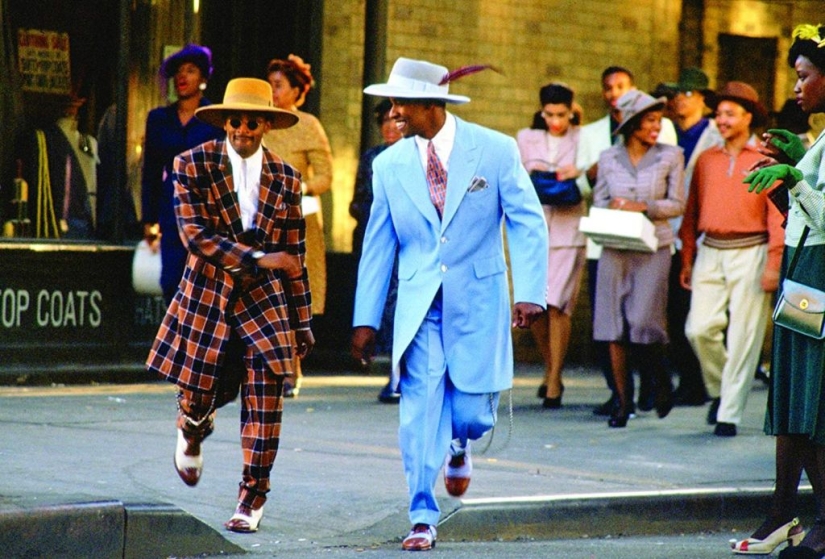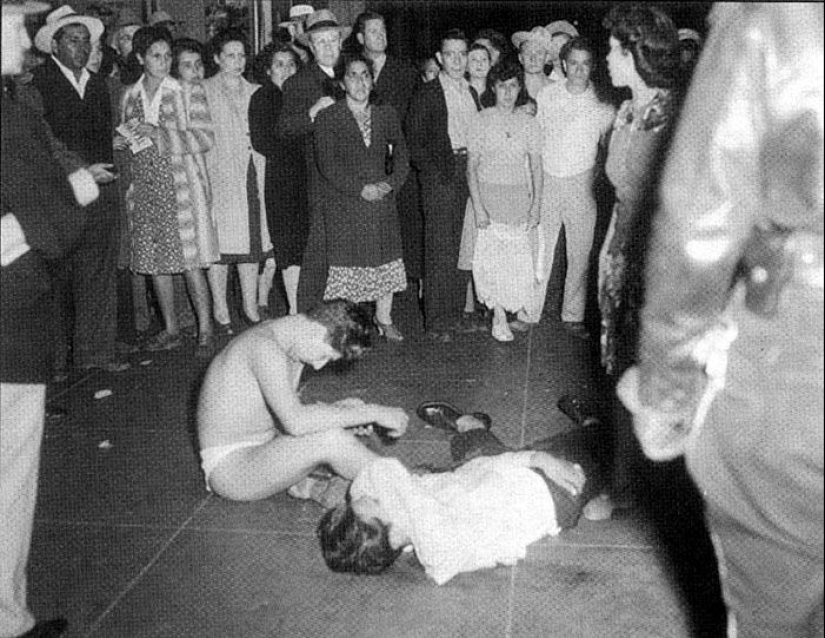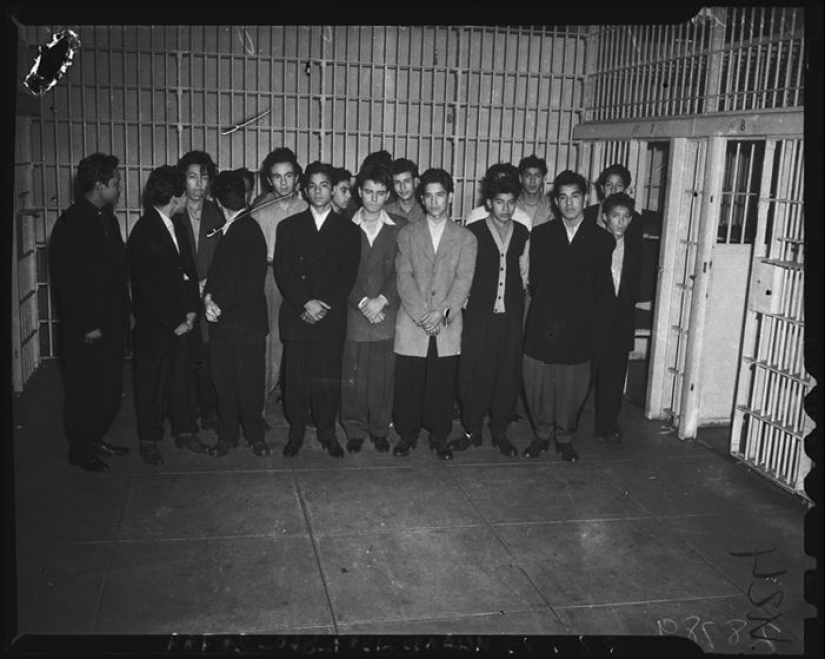How a fancy suit became a symbol of anti-war and racial protests
Sometimes you can express your position on a particular issue through clothing. For example, the famous Phrygian cap has been associated with freedom and equality for centuries. The zoot suit is a much more multifaceted symbol. At first it was chosen by jazzmen, then by participants in anti-war and anti-racist movements. In the end, he “slipped” and became an attribute of the American mafia. But it was this suit of unusual cut that had a huge influence on youth fashion of the 20th century.

Fashion historians are still arguing about when the zoot suit first appeared. It was impossible to determine who first wore baggy high-waisted trousers and an elongated jacket with voluminous shoulders. Most often, the American stand-up comedian Ernest “Frying Pan” Mayhand is mentioned as the pioneer of this style. The comedian appeared on stage in a similar outfit in the early 30s of the last century.

Another version says that “zoot” was invented by clothier Harold S. Fox, who in his free time played trumpet in one of the big bands in Chicago. There are many other options. All of them are united only by time - they definitely started wearing the suit in the 30s. Surprisingly, even the origin of the word “zoot” is unknown. Most likely, this is a distorted African-American pronunciation of suit (suit), but this is not certain.
The costume quickly became popular among fans of jazz and swing. It became the style of musicians and their listeners, distinguishing them from everyone else. Writer Ralph Ellison, in his book The Invisible Man, described the typical Zoot owner as follows:

It is worth adding to this that the image was almost always complemented by a pocket watch on a long chain, sometimes hanging below the knees. The “stylish” guys preferred rough shoes with thick soles. At first, guys in such clothes could be seen in New York's Harlem, as well as in Chicago and Detroit. But very soon “zoot” spread beyond the boundaries of jazz society and the eastern states.
The real boom around this style began in 1942, after the release of the pop hit A Zoot Suit (For My Sunday Gal), written by songwriters L. Wolfe Gilbert and Bob O'Brien. Just a year later, “zoot” appeared on movie screens. Jazzman Cab Calloway wore a suit of this cut in the 1943 musical Stormy Weather. The musician himself claimed that this was “the only completely and truly American civilian costume.”
Since the “zoot suit” did not restrict movement and looked stylish and brutal, members of criminal gangs soon began to wear it. By the end of the 40s, the suit had become a real gangster uniform. The criminals' love of fashionable styles served him badly. Wearers of baggy pants and jackets with huge shoulders began to be looked at askance. The Los Angeles Times and The Life added fuel to the fire by convincing Americans that a law-abiding citizen would not wear a zoot.

But that was not the case. Most of the fans of this style belonged to national minorities. These are people with a low standard of living who are willing to do any job to feed themselves and their families. For them, the costume was not only a way of self-identification, but also a special form of protest. They were expected to "know their place" and dress modestly. But they, on the contrary, showed off, showing off.

The zoot suit had a rather complex cut and required a lot of fabric. Therefore, its owners believed that they looked like wealthy guys who managed to get out of poverty. This style became especially popular among the pachuquismo, a youth subculture of Mexicans living in the United States.

This fashion also had a feminine style. The companions of the "tough guys" from the slums wore tight sweaters and wide, flared skirts. The look was completed with a high hairstyle, massive earrings and bright, rough makeup. Most often, Mexican women dressed up like this, who were called “pachucas” in slang.
There have been dark times in the history of the zoot suit. No, the style was not banned, but it made life much more difficult for its fans. This happened in 1941, when the United States introduced a policy of “reasonable economy” in connection with the war. Wasteful use of fabric began to be condemned. In 1942, the screws were tightened even more, as the War Production Board issued general regulations that effectively prohibited the production of oversized suits. Wide women's skirts and dresses also fell into disgrace.

No one forbade wearing fashionable clothes. But there were problems with its sewing. Clothing companies have curtailed their production of zoots and removed them from advertising. Small ateliers also refused to take on tailoring. In this regard, the phenomenon of bootleg tailors appeared in the United States. They were called by analogy with the bootleggers of the Prohibition era who sold alcohol illegally.
Los Angeles and New York have become centers of illegal fashion tailoring. Of course, the price of “zoots” has skyrocketed, and they are not available to everyone. Those who purchased the suits before the war treated them with the utmost care. A person in such clothes was perceived ambiguously in society. Patriotic Americans believed that the pretentiously dressed dudes were deliberately ignoring the hardships of war, challenging them.
The matter was not always limited to silent disapproval. Sometimes conflicts occurred that caused resonance. In 1942, in Los Angeles, a military sailor on leave was walking with a girl along the street of Chinatown. Four “zooters” were walking towards them, and the young man reprimanded them. A skirmish broke out, during which the mods became rude to the sailor and pushed him off the sidewalk onto the roadway.

The local press wrote about this incident. The incident caused indignation among many townspeople and especially among the military. But at that time things did not come to an open confrontation. It happened a year later, on the night of June 3, 1943. Then 11 sailors in the center of Los Angeles got into a fight with a company of “zooters.” The latter won, and the reaction of society is not difficult to predict.
The very next day, the newspapers were full of headlines like “Zooters beat and stabbed military personnel!” Attacks on military personnel during the war were perceived as a serious crime. After that, about 200 sailors piled into taxis and headed to East Los Angeles. It was there that the Mexican community lived compactly.
Sailors began combing the area, catching guys in zoots. They were punched, kicked and beaten with batons and their clothes were torn off. The loot was piled up and burned. This went on for several days. Journalists commented on these pogroms with undisguised approval. Soon the military was joined by patriotic civilians.

In one of the cinemas, sailors placed two Mexicans near the screen, tore off their clothes and urinated on them. Journalist Carey McWilliams wrote in those days:

During the massacre, more than 150 people were seriously injured. 500 Mexicans and African Americans were arrested by the police. They were charged with organizing riots and vagrancy. Only on July 8 did the military command manage to stop the massacre. All sailors were ordered to urgently return to the barracks. The story of the “zooters” had serious consequences. One of them was the deterioration of relations between the United States and Mexico.
The events of July 1943 finally cemented the zoot's reputation as protest clothing. This is how Malcolm Little, the future radical leader of the African-American population, and Cesar Estrada Chavez, a fighter for the rights of workers, national minorities and migrants, dressed.

In the 40s, similar costumes appeared in other countries. The zazou style became popular among French working-class youth. Its representatives chose loose-fitting striped or checkered suits. The jackets were made with wide padded shoulders, and the look was complemented with suede low shoes with thick soles. In the Czech Republic, their own “zooters” appeared, calling themselves “potapky”, that is, “toadstools”. In Hitler's Germany, these guys called themselves Swing Kids (Swingjugend).

The “zoot” style successfully survived the war and formed the basis of many new youth subcultures. Among them are British teddy boys, or teddy boys, as well as Soviet dudes. And in the USA, the style suddenly turned from marginal to respectable. Frank Sinatra, who often appeared in a similar image, influenced his perception. The singer, associated with the mafia, wanted to express respect for its members in this way. Thanks to him, the “Sinatra-style zoot” became a stereotype in films about organized crime for a long time.
Recent articles

Most of us think that the color of the eggshell does not play any role and it is possible not to pay attention. But it's not and ...

The more we rely on technology, the more potential power hackers gain over us. It doesn't matter if their goal is to help or cause ...

Creating a good portrait is one of the most difficult tasks for any photographer. In order to make a really natural and memorable ...